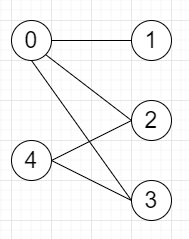Program to check whether given graph is bipartite or not in Python
https://www.tutorialspoint.com/program-to-check-whether-given-graph-is-bipartite-or-not-in-python
-
07-10-2020 - |
Question
Program to check whether given graph is bipartite or not in Python
Suppose we have one undirected graph, we have to check whether the graph is bipartite or not. As we know a graph is bipartite when we can split the nodes of the graph into two sets A and B such that every edge {u,v} in the graph has one node u in A and another node v in B.
So, if the input is like

Then the output will be True, [0,4] are in set A and [1,2,3] are in set B, and all edges are from A to B or B to A, not A to A or B to B.
To solve this, we will follow these steps−
Define a function dfs() . This will take source
for each vertex in graph[source], do
if color[vertex] is not same as -1, then
if color[vertex] is same as color[source], then
result[0] := False
return
go for the next iteration
color[vertex] := 1 - color[source]
dfs(vertex)
From the main method, do the following−
n := size of arr
graph := empty adjacency list for vertices 0 to n-1
for i in range 0 to n, do
for each j in arr[i], do
insert i into graph[j]
insert j into graph[i]
color := a list of size n and fill with -1
result := a list with one True value
for i in range 0 to n, do
if color[i] is same as -1, then
dfs(i)
return result[0]
Let us see the following implementation to get better understanding −
Example
from collections import defaultdict class Solution: def solve(self, arr): n = len(arr) graph = [set() for i in range(n)] for i in range(n): for j in arr[i]: graph[j].add(i) graph[i].add(j) color = [-1] * n result = [True] def dfs(source): for child in graph[source]: if color[child] != -1: if color[child] == color[source]: result[0] = False return continue color[child] = 1 - color[source] dfs(child) for i in range(n): if color[i] == -1: dfs(i) return result[0] ob = Solution() graph = [[1,2,3],[0],[0,4],[0,4],[2,3]] print(ob.solve(graph))
Input
graph = [[1,2,3],[0],[0,4],[0,4],[2,3]]
Output
True
